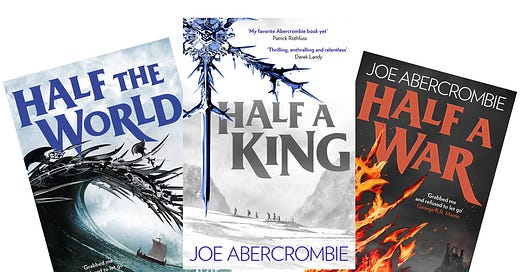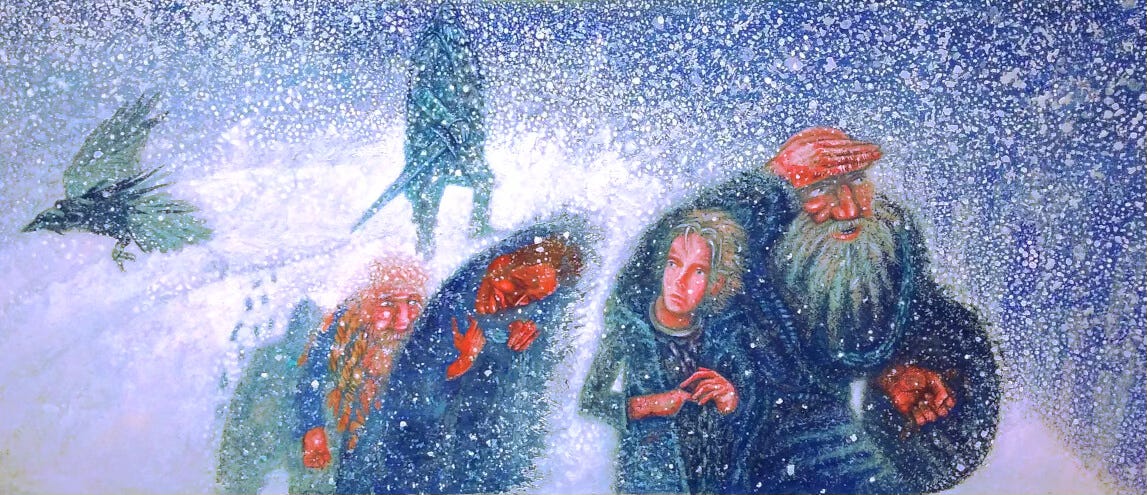Review #3 of 2024: The Shattered Sea Trilogy by Joe Abercrombie
A young adult version of the First Law Trilogy. Bittersweet grim-dark, but this time with extra servings of romance
In an attempt to get more of my reading done in Spanish and get through some of my Goodreads, TBR backlogs, I’ve been reading children’s and young adult fantasy translations. While I probably should be reading novels originally written in Spanish rather than in English, and the translation almost certainly impacts the quality of the story for the worse (a topic for another blog post), making these books a language-learning activity is the only way in which some of them are going to get read. I also have quite the association between Joe Abercrombie’s work and the Spanish language: out of the ten of his books that I’ve read, seven have been in Spanish. However, the review that follows will be in English, you can find my reviews of the individual books in Spanish on my Goodreads profile.
Joe Abercrombie is a British fantasy writer most famous for his First Law trilogy. I talk a little about this first trilogy in this blog post, but in short, Abercrombie’s books are some of the best-executed examples of bittersweetness in fantasy.1 What do I mean by this? The characters in the First Law and Shattered Sea Trilogies often get what they want by the end of the narrative, but there is almost always a catch. Maybe their character development has caused them not to want what they once wanted anymore, the cost of success was too high, or the realities of the role that they desired to play are not what they seem from the outside. Almost all of this tension is character driven, which is a wonderful change from heavy worldbuilding of Tolkien, and Brandon Sanderson, who I find to be much weaker on the character front.
However, the character-driven nature of these books does not mean that the world-building and plot are not excellent as well. Set in a fantasy realm reminiscent of the Baltic Sea of the early Middle Ages2, the three books follow three different sets of view point characters within a larger struggle between the kingdom of Gettland and the High King of the whole of the Shattered Sea. The first book, Half a King, follows Prince Yarvi, who swore an oath to avenge his father’s killers and reclaim his throne. The second book, Half a World, follows two commoners, Brand and Thorn, who serve under Yarvi as he tries to find allies in the larger struggle against the High King. The final book, Half a War, follows three new characters: Yarvi’s apprentice Koll, the warrior Raith, and the Queen of Trovenland, Skara, during the thick of the actual fighting.
While I am not going to discuss plot points in much detail, the remainder of the essay will contain BIG PICTURE SPOILERS for all of the Shattered Sea trilogy. There are three aspects of these books that I found especially interesting that I want to discuss. The first is the strain of political nihilism that seems to run through the trilogy, and most of Abercrombie’s work. The second is the use of perspective to highlight character development. Finally, I’ll touch on how the interpersonal relationships make the bitterness of these books a little sweeter.
“Everyone finds a way to make their side the right one, after all.”
We live in an ideological age. It is easy to assign blame to the ways things are to an electoral loss to an enemy party, or political loss to an enemy country: “If only Florida had gone for Gore in the 2000 election”, “if only the treaty of Versailles wasn’t agreed to by the German government”, “if only the South had won the Civil War”, “if only Trotsky, not Stalin, had been in charge of the Soviet Union”. But for much of history, ideology didn’t really matter. If you were a peasant in medieval or early modern Europe, it didn’t matter if you were ruled by the King of France of the Queen of England, your daily life was almost exactly the same. While there was some amount of variation between states, in order to be a ruler, you had to do things almost exactly the same way in order to hold onto power. Tax the peasants just enough to feed your armies and fund your lifestyle but not enough for them to revolt. Make and break whatever promises to your vassals and to the clergy that were necessary to keep everyone in line. Do whatever it takes to maintain the system, but not too much, or it’ll rock the boat, and you will be replaced.
In this kind of system, fundamental political change is impossible, at least according to Abercrombie. We saw this in the First Law trilogy with the relationship between Jezal and Bayaz. Jezal couldn’t actually do anything that fundamentally changed the direction of his state without being replaced by the system (Bayaz). Hence the state did not change. We see something similar in the Shattered Sea. At the start of the trilogy, Prince Yarvi and his family are victims of a political system that seeks to maintain power equally between its vassals, and sees a need to knockdown Gettland to protect its own power. By the end of the trilogy, Yarvi, now an important member of the clergy, has overcome the existing rulers of the system, but now finds himself in the exact same position as his former adversary, with a need to do commit injustices in order to maintain his grip on power. From an outside perspective, nothing has really changed. Perhaps Abercrombie is suggesting that to really make a difference in the world, seeking power is not the way to go.
“Maybe no one’s all one or all the other.”
One of the most interesting things that this trilogy does is to replace the point of view characters between books. While I wasn’t sure about this while reading the trilogy, I deeply missed Yarvi’s perspective in the second book, and Brand’s in the third, I think this works as a literary device very well for me in hindsight. Unlike the First Law, these books are for Young Adults, and contain a heavy element of bildungsroman. The point of view characters in each book undergo a boatload of personal development befitting of the genre. That’s usually where the story ends, but that’s not the case in real life. In real life, after you’ve undergone your quest and subsequent transformation, it’s your turn to be the secondary character in someone else’s story: the mentor figure, the father figure, the villain. That doesn’t mean your character development stops, but you’re not the main character anymore. We see this with Yarvi, who becomes a mentor figure in the second book and a secondary villain in the third book, and with both Brand and Thorn, who take on the big brother and mentor archetypes, respectively, in the third book.
“I love her in spite of it. I love her because of it. I love her.”
The political nihilism of Abercrombie’s work makes it sometimes difficult to read. However, what makes these three books bittersweet, rather than just bitter is the emphasis on the durability of love in personal relationships. Love does genuinely exist between deeply flawed people (Brand and Thorn). Good people are rewarded for their actions, eventually (Blue Jenner and Queen Skara). Feelings can develop between people thrust together for political reasons on a foundation of respect and kindness (Lathlin and Uthil). Being with someone who sees the best in you is more important than wielding power (Koll and Rin).
Perhaps what Abercrombie is trying to tell us with these books is that the large abstract problems of power and governance aren’t so important: someone else is always going to do that job. Rather, where we can make a real difference is in our interpersonal relationships. Perhaps it would serve us better to focus on those.
If you liked this review, please subscribe to the newsletter! This year I will be aiming for a blog post a week, following a rotation of personal updates, book reviews, running writings, and crunchy updates, as well as Spanish and Italian learning updates as we get to them. If you’d like to chat about Abercrombie or anything else, leave a comment below or shoot me an email at deusexvitablog@gmail.com.
Another is GRRM, but he isn’t managing to finish his trilogies.
It is clear by book 2 or 3 that the world is actually Earth after a nuclear exchange, meaning the Baltic Sea is the real Baltic Sea.






